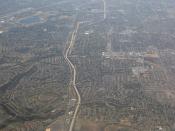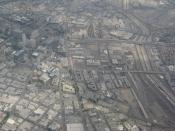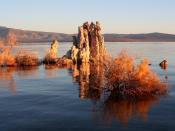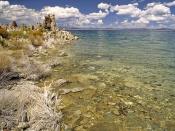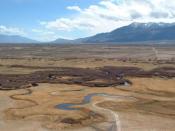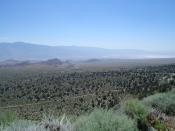Water Theft The City of Los Angeles has flourished to a metropolitan city in the past decade. L.A has become the third largest city in United States and fifth largest city in the world. Every day, thousands of people travel into L.A., amazed at its magnificent towering buildings and employment opportunities. But what people didn't realize are the thefts it has committed to become the city it is today. L.A., practically, took most of water from Eastern Sierra Mountain, leaving them nothing but dust to live on. Was it right for L.A. to take away water that didn't belong to them? Two most known atrocities of L.A.'s theft are the Owens Lake and Mono Lake.
In the early 1900's, the valley of Lake Owen and Mono were primarily home to the small farms and ranches. Even though, there was enough water flowing through the lakes, there were no dams, or money for irrigation projects.
In 1902, with the passage of the National Reclamation Act, hopes ran high in the valley that the government would help the valley develop its water resources. Meanwhile down in Los Angeles, by the early 1900's, it was clear that new water sources were needed to support continued growth. The Los Angeles River, which had served as L.A.'s primary source of water for its first century of existence, was proving insufficient to the demands being made on it. By 1902, the control of the city's water was turned over to a newly created municipal organization, the Water Department, which was overseen by a seven member Board of Water Commissioners. William Mulholland became the first superintendent of this new department.
Mulholland looked for new water resources and Fred Eaton, a former mayor of L.A, and an engineer, brought the Eastern Sierra Mountain to his attention. But the federal Reclamation Service also had its eye on the valley as a possible candidate for an irrigation project. Lippincott, supervising engineer for the Reclamation Service, was the man in charge of putting together recommendations for the government. His efforts for the Reclamation Service resulted only in the valley's public lands being set aside for future development; no rights to the land were secured. So what Eaton and Mulholland did was quietly set about buying up options on strategic land in the valley-land needed for construction of an aqueduct-under different name. For those curious valley residents, they implied that they were from the Reclamation Service, and cheated them into selling the lands. So the lands that were supposed to be used for irrigation projects, were instead sold over to L.A. aqueduct project. Thus the residents of Eastern Sierra Mountain,--who had expected to be the beneficiaries of a federal irrigation project--found themselves to be cheated.
By 1923, the 250 mile long aqueduct was built and started sending the water down to L.A-water that was supposed to be used to irrigate the valley's farmlands. From 1923 to recent years, the water level of both Owens Lake and Mono Lake decreased greatly, because L.A took away the only water input for both lakes.
I recently visited these two places on a field study program at Hancock College. What I saw at Owens Lake was nothing but dust. I saw a field of desert that could have been a beautiful lake--full of water which is surrounded by green trees and beautifully carved rocks. It makes me wonder if there was a lake at all. Only thing you saw was miles of desert with a small pile of salt. Few years ago, the city of L.A., feeling guilt for the atrocity it has created, cut down all the dead trees that surrounded the lake, so that visitors would just pass by without knowing there supposedly was a lake at all. Even for me, if I wasn't notified of L.A.'s theft, I would have just passed the place without knowing how the lake came to be a dry lake. On the other hand, Mono Lake is not a dry lake, but the size decreased to approximately half of its original, dating back to 1940. When I walked to the shore of the Mono Lake, I was actually walking through soils that were under water 50 years ago.
In order to bring these atrocities done by L.A. to justice, several environmentalist filed a lawsuit against city of L.A.. In 1994, after years of foot-dragging and fruitless litigation, the city of L.A gave up some of its pristine eastern Sierra water supply to save Mono Lake. Every year, over a million birds stop by at Mono Lake, and water is a source these birds need. For the survivor of these birds, the court ordered L.A. to refill the water in Mono Lake-approximately, 3 feet of water is pumped into it each year. In 1997, the city ended a 20-year legal struggle with Inyo County and agreed to limit ground water pumping that was destroying vegetation in the Owens Valley. Thus L.A has agreed to control toxic dust blowing from the dry bed of Owens Lake. So each year, L.A is pumping up to 4.5 million gallons of water to keep the soils wet. Now, the toxic dust is under control and L.A is pumping more water to rinse the soil so that residents could harvest on them.
In the past decade, what's left of Owens Lake is a dusty icon of western water war. While L.A. was rising to be the one of the largest cities, Owens Valley was turning into a desolate ghost town. The residents of Owens Valley were the victims of flourishing L.A., and who knows what other side effects occurred due to the L.A Aqueduct. The measures taken in order to reestablish farmlands and water are just a small action to pay back for what L.A has done. Today, the visitors often hear that the water barons inadvertently saved the valley from the overdevelopment and overcrowding that has plagued so much of California. But this is just one of L.A.'s propaganda to get out of the theft they have committed. The visitors should instead consider how much more beautiful the valley would have looked if L.A didn't steal its water.
